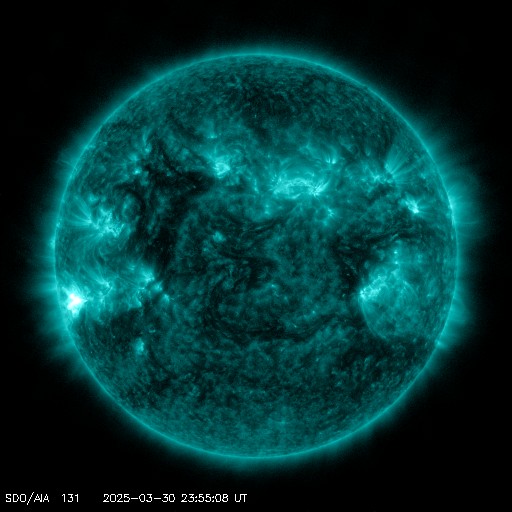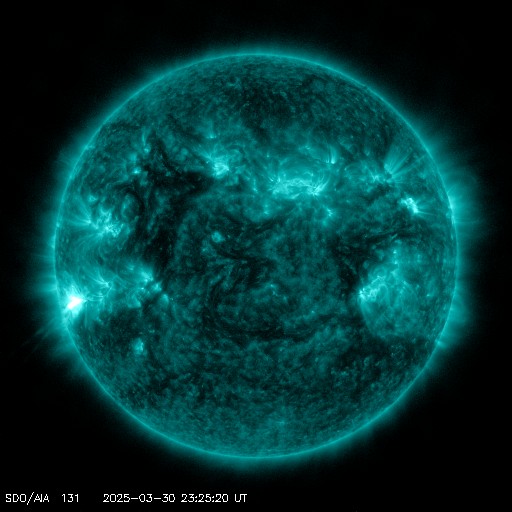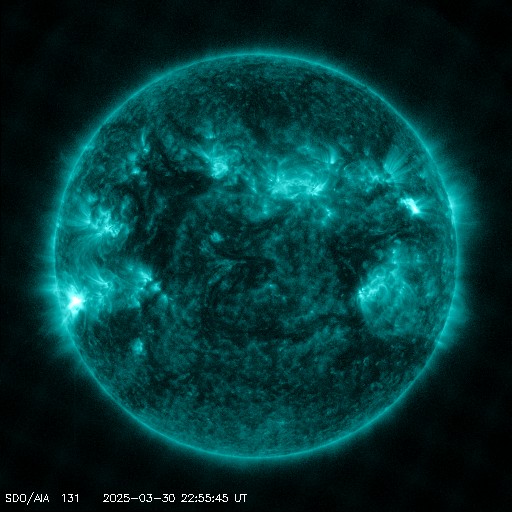Viewing archive of Saturday, 2 July 2005
Solar activity report
Any mentioned solar flare in this report has a scaling factor applied by the Space Weather Prediction Center (SWPC). Because of the SWPC scaling factor, solar flares are reported as 42% smaller than for the science quality data. The scaling factor has been removed from our archived solar flare data to reflect the true physical units.
Report of Solar-Geophysical Activity 2005 Jul 02 2210 UTC# Prepared jointly by the U.S. Dept. of Commerce, NOAA, #Space Environment Center and the U.S. Air Force. #
Joint USAF/NOAA Report of Solar and Geophysical Activity
SDF Number 183 Issued at 2200Z on 02 Jul 2005IA. Analysis of Solar Active Regions and Activity from 01-2100Z to 02-2100Z
Solar activity was low. The majority of today's
activity came from Region 785 (S22W06), which produced five C-class
events. The largest of these was a C3/Sf at 0316 UTC. Region 785 has
shown steady growth during the past 24 hours. An additional C-flare
(C1 at 1614 UTC) was produced by Region 786 (N10E62). Region 783
(S06E21) is currently the largest group on the disk with an area of
570 millionths, but was stable and quiet. New Region 788 (S07E71)
rotated into view today and is a simple H-type spot.
IB. Solar Activity Forecast
Solar activity is expected to be
mostly low, but there is a chance for an isolated M-class during the
next three days (3-5 July). Of the eight spotted regions on the
disk, 785 and 783 appear to be the most likely sources for future
M-class level activity.
IIA. Geophysical Activity Summary 01-2100Z to 02-2100Z
The geomagnetic field began the period at active levels due to the
effects of a high speed stream from a coronal hole. However, the
interplanetary magnetic field weakened significantly at about 0700
UTC, and conditions have been quiet to unsettled since then. Solar
wind velocities remain elevated but were declining during the past
24 hours, with typical values of 540-560 km/s by forecast issue
time.
IIB. Geophysical Activity Forecast
The geomagnetic field is
expected to be predominantly unsettled, but there is a continued
chance for occasional active periods during the next two days (03-04
July) as effects from the coronal hole are expected to linger.
Conditions should decline to mostly quiet by the third day (05
July).
III. Event Probabilities 03 Jul to 05 Jul
| Class M | 30% | 30% | 30% |
| Class X | 05% | 05% | 05% |
| Proton | 05% | 05% | 05% |
| PCAF | green | ||
IV. Penticton 10.7 cm Flux
Observed 02 Jul 124 Predicted 03 Jul-05 Jul 125/125/130 90 Day Mean 02 Jul 094
V. Geomagnetic A Indices
Observed Afr/Ap 01 Jul 012/016 Estimated Afr/Ap 02 Jul 013/013 Predicted Afr/Ap 03 Jul-05 Jul 010/015-010/018-005/007
VI. Geomagnetic Activity Probabilities 03 Jul to 05 Jul
| A. Middle Latitudes | |||
|---|---|---|---|
| Active | 30% | 30% | 20% |
| Minor storm | 15% | 15% | 10% |
| Major-severe storm | 05% | 05% | 05% |
| B. High Latitudes | |||
|---|---|---|---|
| Active | 35% | 35% | 20% |
| Minor storm | 20% | 20% | 10% |
| Major-severe storm | 05% | 05% | 05% |
All times in UTC
Current data suggests there is a slight possibility for aurora to appear at the following high latitude regions in the near future
Gillam, MB, Whitehorse, YT, Yellowknife, NTFairbanks, AK, Utqiagvik, AK
Latest news
Latest forum messages
Solar Demon 3Unspecified geomagnetic activity 2146AR4046 134Aurora photography hints for those of us with smartphones 54AR4048 34
More topicsSupport SpaceWeatherLive.com!
A lot of people come to SpaceWeatherLive to follow the Sun's activity or if there is aurora to be seen, but with more traffic comes higher server costs. Consider a donation if you enjoy SpaceWeatherLive so we can keep the website online!

Latest alerts
00:09 UTC - Solar flare
Moderate M1.03 flare
Sunday, 30 March 2025
23:51 UTC - Radio Blackout
Minor R1 radio blackout in progress (≥M1 - current: M1.03)
23:39 UTC - Solar flare
Moderate M1.52 flare
23:21 UTC - Radio Blackout
Minor R1 radio blackout in progress (≥M1 - current: M1.49)
23:09 UTC - Solar flare
Moderate M1.48 flare
Space weather facts
| Last X-flare | 2025/03/28 | X1.1 |
| Last M-flare | 2025/03/30 | M1.0 |
| Last geomagnetic storm | 2025/03/27 | Kp5 (G1) |
| Spotless days | |
|---|---|
| Last spotless day | 2022/06/08 |
| Monthly mean Sunspot Number | |
|---|---|
| February 2025 | 154.6 +17.6 |
| March 2025 | 127 -27.6 |
| Last 30 days | 127 -25.7 |





